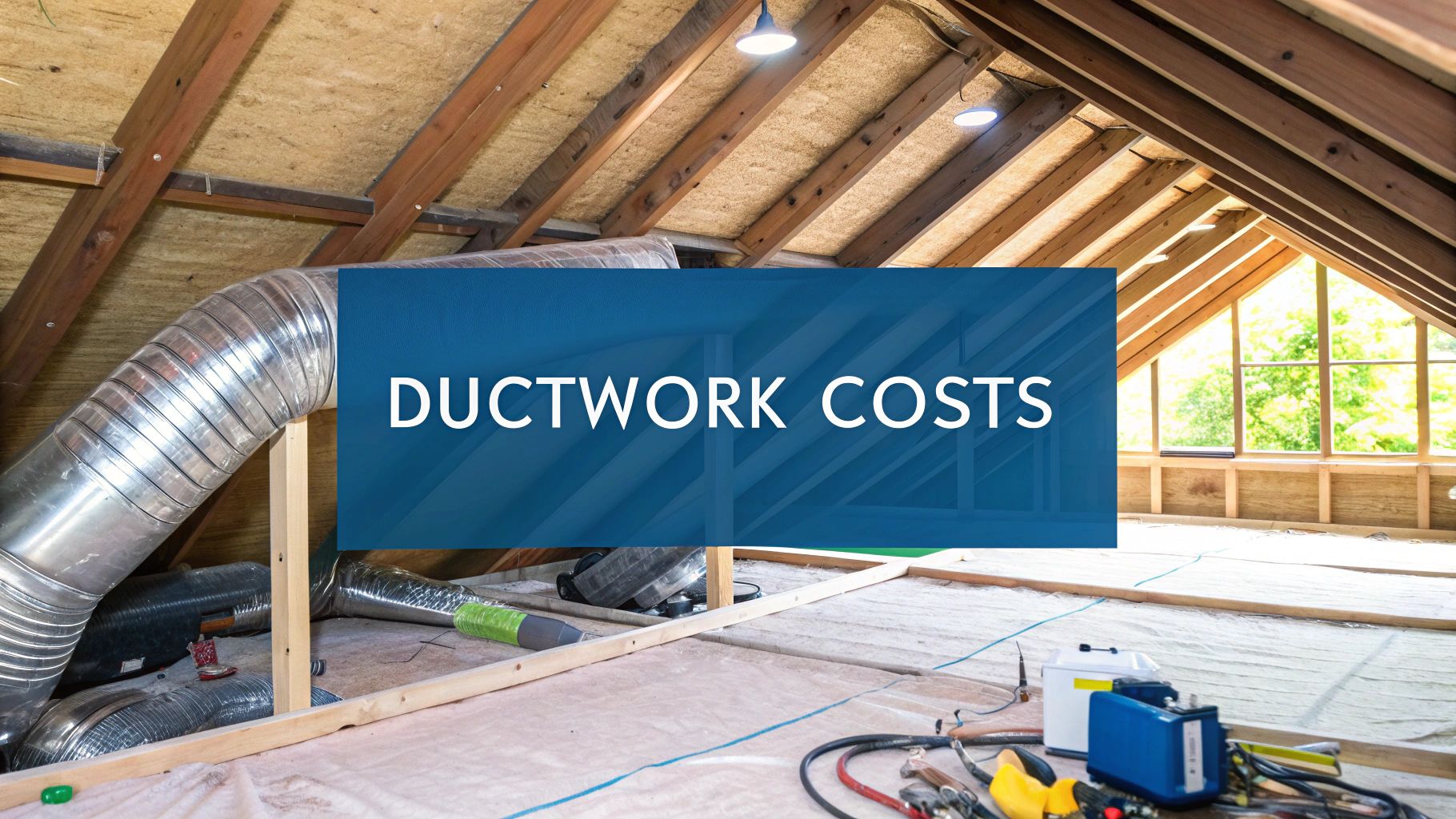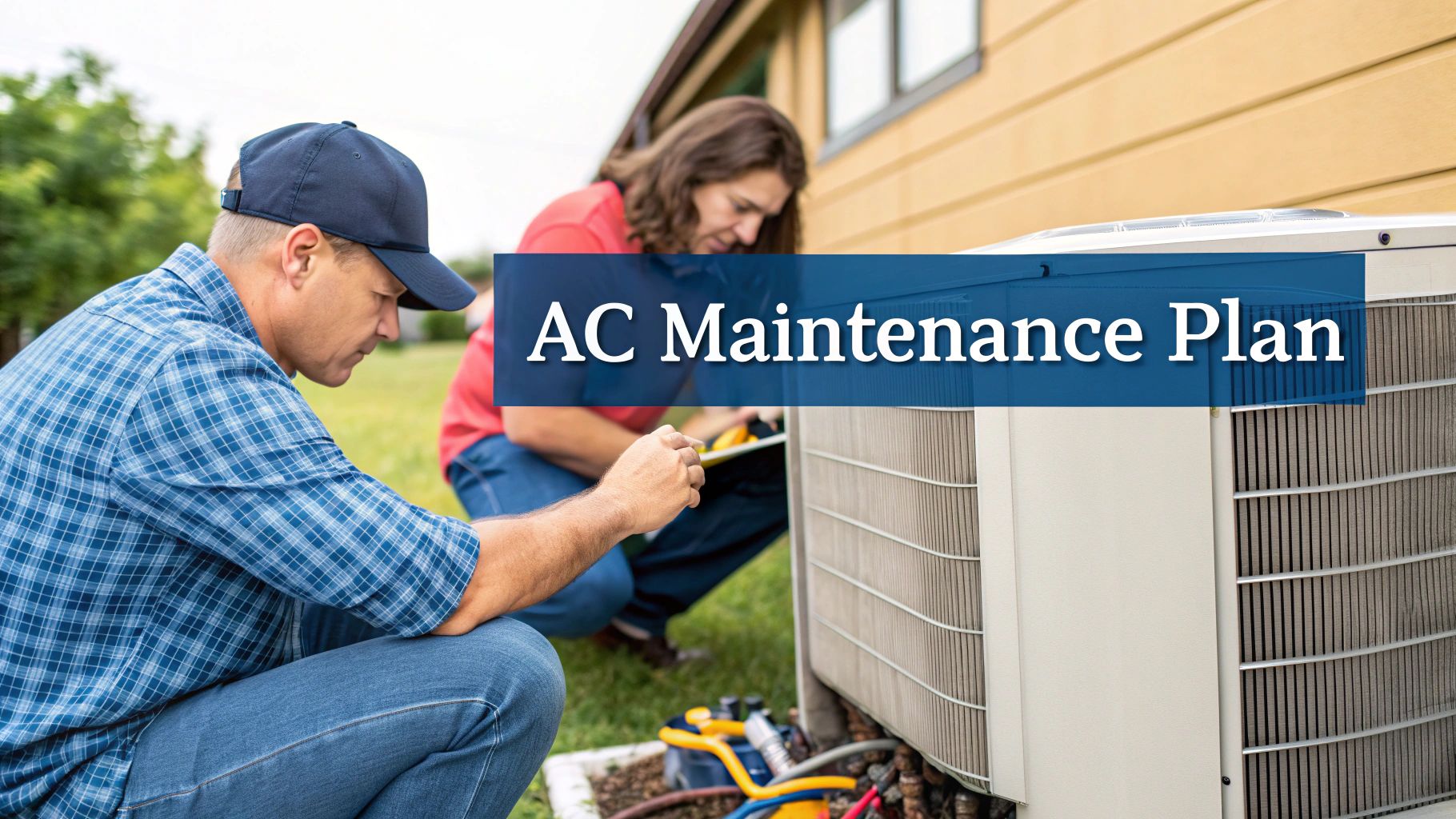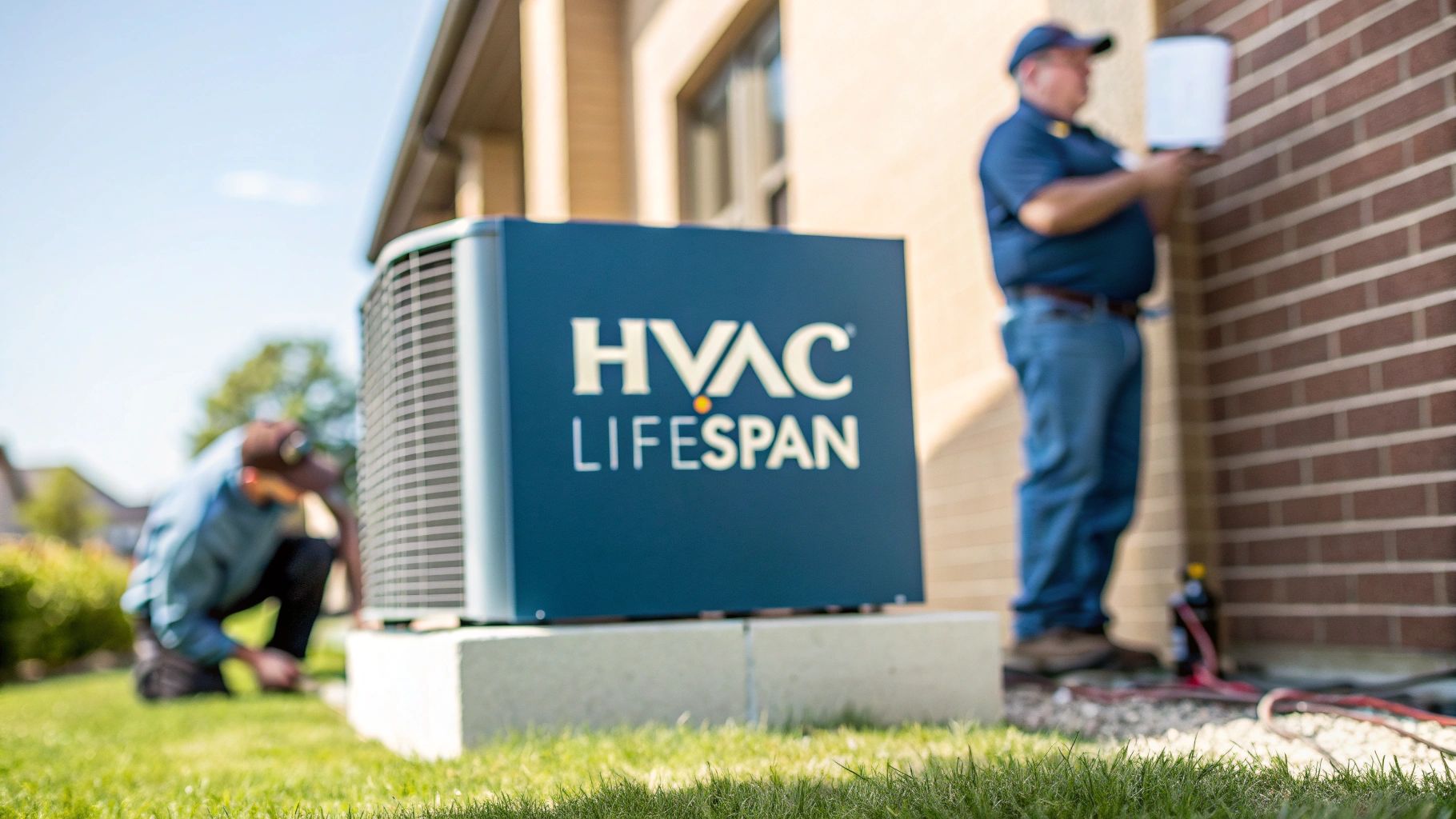When you start looking into replacing your home's ductwork, you'll quickly see a wide range of prices. On average, most homeowners can expect the hvac ductwork replacement cost to land somewhere between $2,000 and $6,000 for a typical single-family house.
Of course, that’s just a ballpark figure. The final bill really comes down to the specifics of your home, the kind of materials you choose, and how tricky the job is.
Understanding Your Ductwork Replacement Cost
Think of your ductwork as your home's respiratory system. It's the network of pathways that delivers fresh, conditioned air from your furnace and AC to every single room. If those pathways are old, full of leaks, or just poorly designed, your HVAC system has to work overtime. This not only wastes a ton of energy and money but also leaves you feeling uncomfortable.
While a full replacement is a serious investment, it’s often the best long-term fix for boosting efficiency, lowering your energy bills, and dramatically improving your indoor air quality.
HVAC Ductwork Replacement Cost At a Glance
To give you a clearer picture right away, here’s a quick breakdown of what you might expect to pay. This table summarizes the typical cost tiers for a ductwork replacement project.
| Cost Level | Average Price Range | What It Typically Includes |
|---|---|---|
| Lower End | $1,500 – $3,000 | Partial replacement or replacement in a smaller home with easy access (e.g., open attic or basement). Usually involves flexible ductwork. |
| Mid-Range | $3,000 – $7,000 | Full replacement for a standard-sized home (1,500-2,500 sq. ft.). A mix of flexible and rigid ducts, with moderate labor complexity. |
| Higher End | $7,000 – $12,000+ | Full replacement for a large or multi-story home. Often includes high-quality materials like sheet metal, complex layouts, or difficult access (tight crawl spaces). |
Remember, these are just estimates. The only way to know for sure is to get a detailed quote from a qualified professional who has seen your home.
Why Do Costs Vary So Much?
That national average is a good starting point, but it rarely paints the full picture for your specific project. The final quote you get is a custom calculation based on your home's unique circumstances.
Simple things you might not think about, like how easy it is to get to the ducts, make a huge difference. Working in a cramped, dusty crawl space is a lot harder—and therefore more expensive—than working in a wide-open attic. Regional labor rates also play a big part in the final cost.
In fact, recent data shows that project costs can swing from as low as $453 for minor repairs to over $2,185 for more involved jobs, with a national average of around $1,251. Your choice of materials is another major factor. Durable sheet metal ducts will cost more upfront than standard flexible ducts, but they also last longer and perform better. You can learn more about how these different factors influence duct replacement pricing on Angi.com.
The infographic below gives you a great visual of how costs can scale based on your home's size.
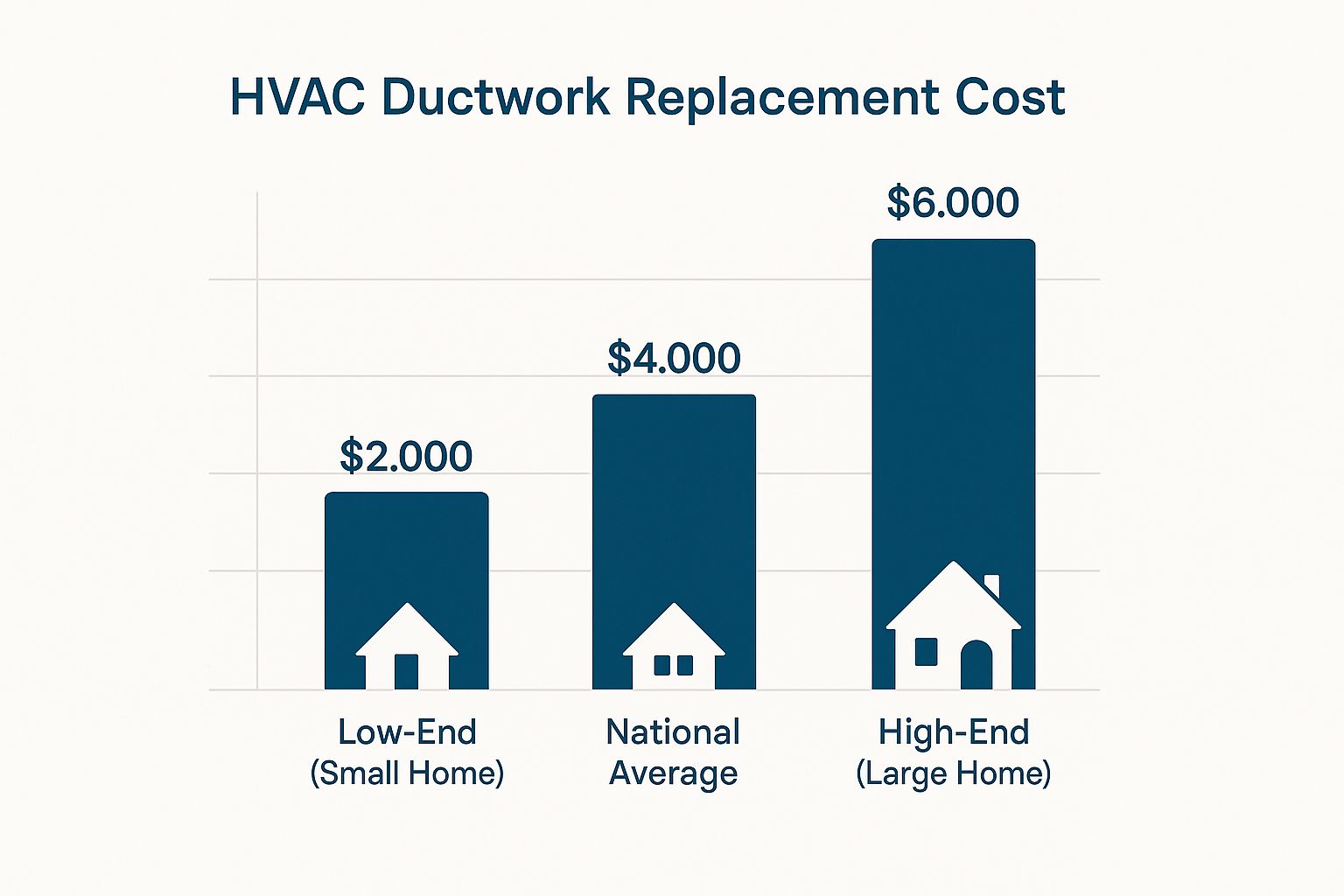
As you can see, the price for a smaller home can be just a fraction of what you might pay for a larger, more complex installation.
Key Takeaway: Your initial hvac ductwork replacement cost estimate is just the beginning. The real price emerges after a professional assesses your home’s unique layout, existing system, and material needs.
What to Expect from a Replacement
A full ductwork replacement isn't just about yanking out old tubes and putting in new ones. It’s a detailed process that a good pro will handle with care.
Here’s what a typical job involves:
- Assess and Design: First, they'll inspect your current system to see where it’s failing. Then, they'll map out a new layout designed specifically for your home to maximize airflow and efficiency.
- Remove Old Ducts: The old, leaky, and inefficient ductwork is carefully taken apart and hauled away.
- Install and Seal: New ducts go in, and this is where the magic happens. Every single joint, seam, and connection is meticulously sealed. This step is absolutely critical, as it prevents the air leaks that waste money and make your HVAC system struggle.
Key Factors That Influence Your Final Price
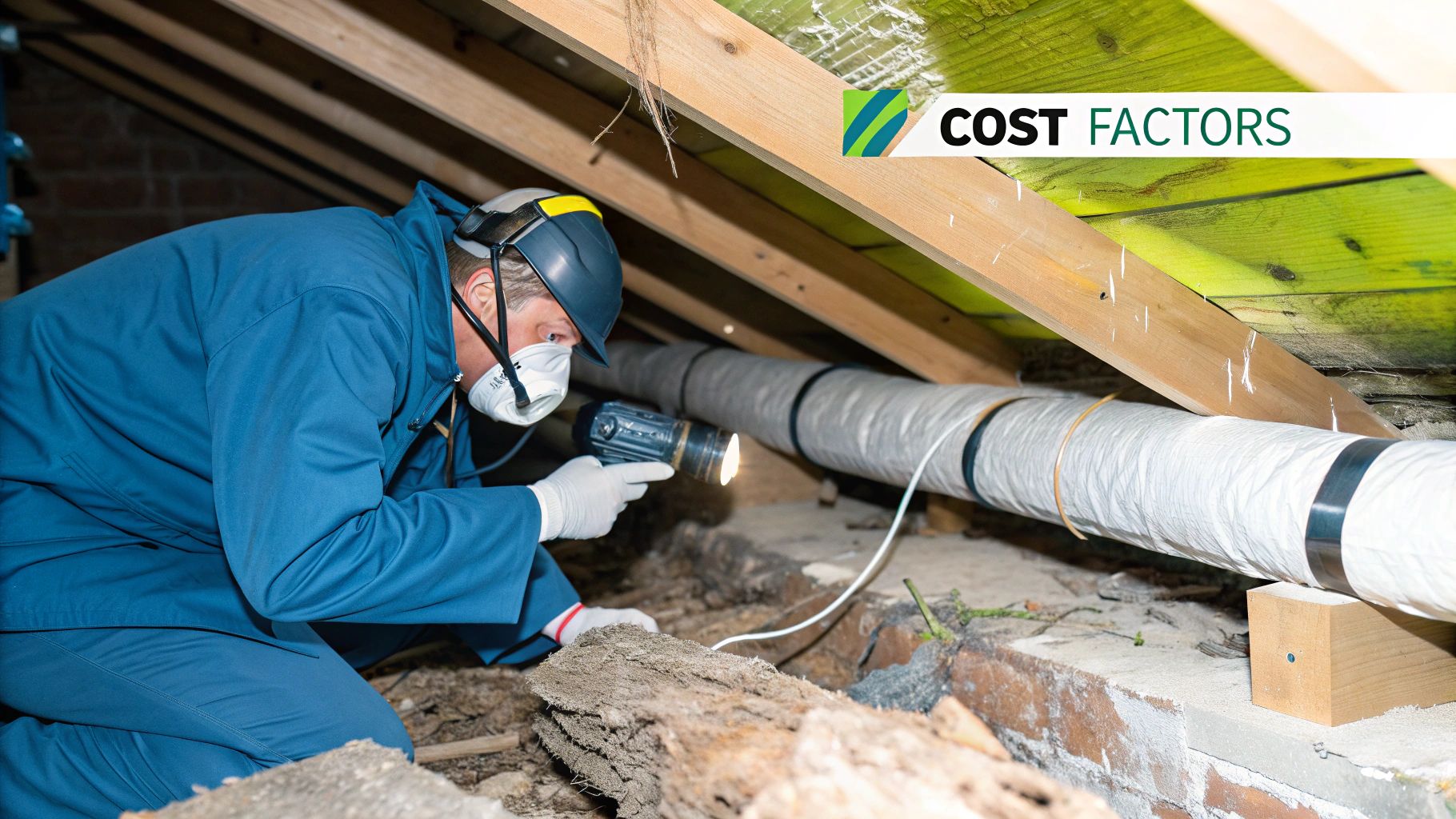
So, you’ve gotten a few quotes for your hvac ductwork replacement cost, and the numbers are all over the map. Why is one contractor thousands of dollars higher than another? It really boils down to a handful of core variables that shape the final price tag.
Think of it this way: you wouldn't expect a sprawling custom-built home to cost the same as a standard two-bedroom condo. The size, materials, and complexity are completely different. Your ductwork project is no different. Every home has its own quirks and needs, and a good contractor prices the job based on the reality of your specific situation, not a generic formula.
Let's break down exactly what those key factors are.
Your Home’s Size And Layout
The biggest piece of the cost puzzle is, without a doubt, the size of your home. A larger house simply needs more ducting to push conditioned air into every corner. More ducts mean more materials and more hours for the installation crew.
It’s a pretty direct relationship—more square footage means a bigger, more complex network of ducts. A rambling 3,000 sq. ft. house will always cost more to re-duct than a tidy 1,200 sq. ft. bungalow. As a ballpark, replacing the ductwork in a home between 2,000 and 2,500 square feet often lands somewhere between $2,500 and $5,000. That's because bigger homes demand a more robust system to keep temperatures even, which bumps up both the material and labor costs. You can learn more about how home size affects ductwork costs at This Old House.
But it's not just about the raw square footage. The home's layout is just as important. A multi-story house with tricky vertical runs is a much bigger challenge than a simple, single-level ranch. The more complex the path the ducts have to take, the more time and skill it takes to install them correctly.
The Type of Ductwork Material
The actual material your new ducts are made from is another major line item on the estimate. Each type has its own price point and offers a different mix of durability, efficiency, and flexibility. A pro will help you choose the right fit based on your home's design, your local climate, and what you're willing to spend.
Pro Tip: Flexible ducts can save you money at the outset, but rigid sheet metal ducts often deliver better long-term value. Their durability and superior airflow can actually lower your energy bills over the life of the system.
Take a look at how these common material choices stack up.
How Ductwork Materials Impact Your Budget
Choosing the right material is a balancing act between upfront cost, long-term performance, and the specific needs of your home. This table breaks down the most common options to help you see how your choice will affect the bottom line.
| Duct Material | Average Cost per Foot (Installed) | Pros | Cons |
|---|---|---|---|
| Flexible Ducts | $6 – $12 | Lower initial cost, easier to install in tight spaces. | Less durable, can be prone to kinks and tears that restrict airflow. |
| Sheet Metal (Rigid) | $10 – $25 | Extremely durable, long lifespan, smooth interior for optimal airflow. | Higher material cost, more labor-intensive to install. |
| Fiberglass Lined | $8 – $18 | Excellent insulation and sound-dampening qualities. | Inner lining can degrade and collect contaminants over time. |
Ultimately, the best material depends on your priorities. If budget is the primary concern, flex ducts are tempting. But if you're looking for a lifetime solution that boosts efficiency, sheet metal is hard to beat.
Accessibility And Labor Complexity
Finally, we get to one of the most overlooked—but hugely important—factors: how easy is it to get to your ducts? Where the ductwork is located has a direct impact on the time and sweat the installation crew has to put in, and that translates straight into labor costs.
Just picture the difference. An installer working in a wide-open, walkable attic has a much easier day than someone who has to shimmy into a cramped, dusty crawlspace full of spiders and pipes. That difficult job is going to take longer and, naturally, cost more.
Here are a few common access issues that can drive up the price:
- Tight Crawlspaces or Attics: When technicians can barely move, it’s much harder to handle bulky materials and properly seal every joint and connection.
- Ducts Buried in Walls or Ceilings: If your ducts are hidden behind drywall, the job suddenly involves demolition and repair work, which adds significant cost and time.
- Complex Home Designs: Houses with vaulted ceilings, split levels, or other unique architectural features often require clever (and time-consuming) routing to get the ductwork where it needs to go.
At the end of the day, the more straightforward the access, the more affordable the labor will be. This is why a thorough, in-person inspection is non-negotiable. It’s the only way for a contractor to spot these challenges and give you a truly accurate quote for your hvac ductwork replacement cost.
Deciding Between Ductwork Repair and Replacement
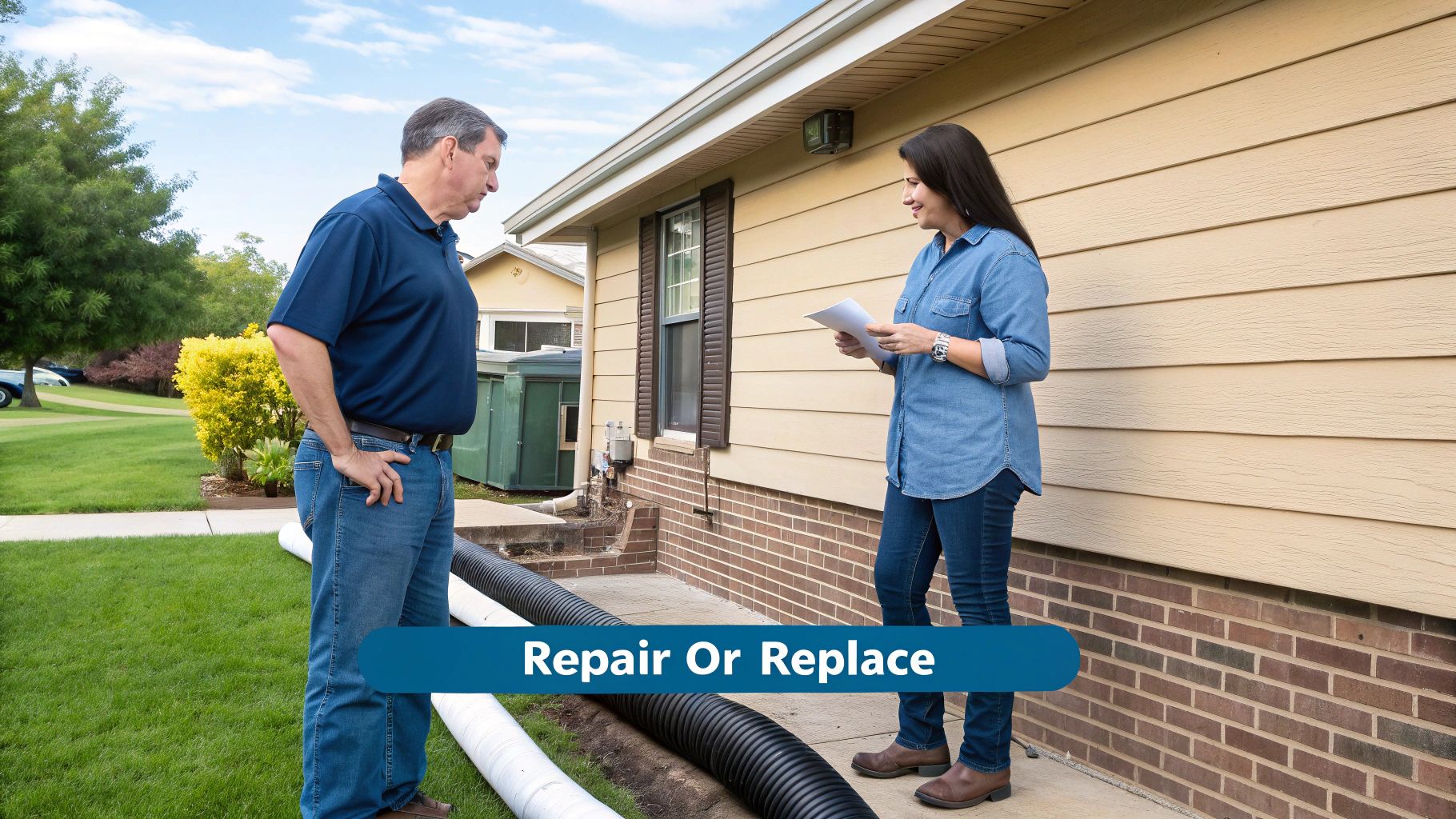
Trying to figure out whether to patch up your existing ductwork or tear it all out and start fresh can be a tough call. It's that classic homeowner's crossroads: is this just a quick fix, or is it a warning sign of a much bigger headache on the horizon?
Think of it like this: you get a flat tire. Sometimes, a simple plug is all you need to get rolling again. But if all four tires are bald and cracking, you know that just patching one is a temporary, and frankly unsafe, solution. The same logic applies directly to your home's ductwork.
Making the right choice here isn't just about the immediate cost. It impacts your comfort, your energy bills, and how well your HVAC system performs for years to come. So, let’s dig into the signals that tell you when a simple repair will do and when the hvac ductwork replacement cost is an investment you need to make.
When a Targeted Repair Makes Sense
Not every ductwork issue is a five-alarm fire demanding a complete overhaul. More often than not, a small, focused repair is the smartest and most budget-friendly move. If your duct system is still relatively young—say, under 15 years old—and the problems are confined to one or two spots, a repair is almost always the right answer.
You should be thinking "repair" if you're dealing with issues like these:
- Minor Leaks or Small Holes: A pro can easily seal up small gaps at the seams with mastic sealant or specialized metal tape. It’s a quick and highly effective fix.
- A Single Disconnected Duct: If one duct has popped loose in an easy-to-reach spot like a basement or attic, simply reattaching and securing it is no big deal.
- Localized Damage: Maybe a single duct run got crushed when someone was in the attic, or a small section was punctured. Replacing just that one piece is way more practical than a full system replacement.
- Loud Noises: Annoying rattling or whistling often points to a loose connection or a minor airflow snag that can be tightened or adjusted without major surgery.
Tackling these smaller problems promptly can make a huge difference in your system's efficiency without the sticker shock of a full replacement.
Clear Signs It Is Time For A Full Replacement
While repairs are great for isolated incidents, some problems are just symptoms of a system that's on its last legs. Constantly patching up an old, crumbling network of ducts is like slapping a new coat of paint on a rotting fence. Sooner or later, you have to deal with the real issue.
A full replacement becomes the smarter long-term play when you start seeing these unmistakable signs.
Age and Deterioration
Ductwork simply doesn't last forever. Most systems have a realistic lifespan of about 15 to 20 years. After that, the materials start to degrade, the seals fail, and the whole network loses its ability to move air efficiently. If your ducts are in that age range, a full replacement is often cheaper in the long run than chasing an endless series of repairs.
Your ductwork is the circulatory system of your home. If it's old and failing, your entire HVAC system suffers, leading to wasted energy, poor air quality, and uncomfortable rooms. Investing in a new system is investing in your home's long-term health.
Persistent Mold and Poor Air Quality
If you're dealing with mold in your ducts that keeps coming back, that’s a major red flag. A professional cleaning can help temporarily, but mold can embed itself deep into the porous materials of older ducts, especially those with fiberglass liners. Sometimes, the only way to get rid of the source for good and protect your family’s health is a full replacement. Keeping your air clean is vital, and it helps to understand what the pros can do. For more on this, you can find helpful information about the best duct cleaning services near me.
Poor Original Design and Performance
Sometimes, the problem isn't how old the ducts are, but how they were installed in the first place. Was the system just poorly designed from day one?
Common signs of a bad layout include:
- That one room that's always sweltering in the summer or freezing in the winter.
- Barely any air coming out of certain vents.
- An HVAC system that seems to run nonstop but can never quite get the temperature right.
If your home has always had these problems, no amount of repairs can fix a fundamentally flawed design. A full replacement allows a professional to map out and install ductwork that's properly sized for your home, finally giving you the consistent, balanced comfort you should have had all along.
The Real Benefits of Investing in New Ductwork
It’s easy to look at the hvac ductwork replacement cost and see it as just another big, unavoidable repair bill. But that’s the wrong way to think about it. It’s actually one of the smartest upgrades you can make for your home’s health, efficiency, and overall comfort.
Think of it this way: old, leaky ductwork is like trying to water your garden with a hose full of holes. You’re losing most of the water before it ever gets to the plants. Your HVAC system works hard to heat and cool air, but old ducts let a huge chunk of it escape into your attic, walls, or crawlspace. A brand-new, professionally sealed system changes all that.
Drastically Lower Your Energy Bills
The first thing you’ll notice—and love—is the drop in your monthly energy bills. Leaky ducts are a notorious energy thief, forcing your furnace and air conditioner to run constantly just to keep up.
When you swap out that failing network for an airtight one, you’re giving your HVAC system a huge efficiency boost. It doesn't have to work nearly as hard, which not only slashes your energy use but also reduces wear and tear on your expensive equipment.
Financially, it really adds up. A full duct replacement can cut your energy bills by 10% to 40%. This is especially true in older homes where ducts, which typically last around 15-20 years, are long past their prime.
Key Insight: New ductwork isn't just a repair; it's a powerful energy-saving tool. The money you save each month on your utility bills actively helps pay back the initial cost over time.
Breathe Cleaner, Healthier Air
Beyond the savings, new ductwork delivers something priceless: better air for your family to breathe. Over the years, old ducts become a hidden collection bin for dust, pet dander, pollen, mold spores, and all sorts of other gunk.
Every time your system kicks on, it blasts those contaminants and allergens throughout your home.
Replacing your ductwork is like giving your home a full respiratory detox. You’re physically removing years of built-up grime and potential mold. The result is cleaner, fresher air in every room—a real game-changer for anyone with allergies, asthma, or other sensitivities. To maintain a healthy environment, it's helpful to know how often air quality testing should be done.
Achieve Consistent Home Comfort
Do you have one room that’s always freezing and another that’s constantly stuffy? Those annoying hot and cold spots are almost always caused by bad ductwork—crushed, disconnected, or leaky sections that just can't deliver air where it needs to go.
A professional replacement isn’t just about installing new tubes. It’s about designing a balanced system that’s right for your home’s specific layout. This means every room gets the right amount of airflow, every time.
A well-designed system delivers immediate benefits:
- No More Hot and Cold Spots: Finally, you get a consistent, comfortable temperature throughout the house.
- Stronger Airflow: You'll feel a real difference in the air coming from your vents.
- Quieter System: Properly sealed and supported ducts get rid of the rattles, whistles, and banging noises that plague old systems.
Ultimately, new ductwork makes your home a far more comfortable and efficient place to live. If you’re hunting for other ways to boost your home’s performance, take a look at our guide on HVAC energy-saving tips.
Finding and Hiring the Right HVAC Contractor

Choosing the right professional for your ductwork replacement is just as important as the project itself. The quality of the installation has a huge impact on your system's efficiency, its lifespan, and how well it actually works. A great contractor gets the job done right; a bad one can cause years of headaches and wasted money.
Don't rush this part. Taking the time to find and properly vet a trustworthy HVAC expert is one of the smartest things you can do to manage your hvac ductwork replacement cost and make sure everything goes smoothly.
The Power of Multiple Quotes
Here's a golden rule: never, ever settle for the first estimate you get. You should always aim for at least three detailed, written quotes from different licensed contractors. This isn't just about hunting for the lowest price—it’s about seeing how different pros approach your home's unique needs.
A suspiciously low offer might look good on paper, but it can be a huge red flag for cheap materials or inexperienced labor. On the flip side, an unusually high quote might just be overcharging. Getting several bids helps you establish a realistic baseline for what your project should actually cost.
What to Look for in a Quality Quote
A professional quote is much more than a single number. It should be a clear, detailed document that breaks down every single part of the job. If a contractor just gives you a vague, one-line estimate, that’s a warning sign.
A solid, comprehensive quote should always include:
- Itemized Material Costs: A specific list of the types and amounts of ductwork and other materials needed.
- Detailed Labor Charges: A clear explanation of the labor rates and how long they expect the project to take.
- Project Scope: A full description of the work to be done, including tearing out the old ducts and cleaning up afterward.
- Warranty Information: The nitty-gritty details on warranties covering both the new materials and the installation work.
- Permit and Inspection Fees: Any costs for local permits, which any reputable contractor will handle for you.
Crucial Questions to Ask Every Contractor
Once you've got a few quotes, it's interview time. This is your chance to get a feel for their expertise, professionalism, and overall reliability. Don't be afraid to ask direct questions—a confident, qualified pro will have no problem answering them.
Key Takeaway: How willing a contractor is to answer your questions is a great sign of their professionalism. Vague or dismissive responses are a clear red flag.
When you're sizing up potential HVAC companies, look for ones that make communication a priority. Understanding their essential client communication best practices can help you spot a team that believes in being upfront and transparent.
Before you make your final call, be sure to ask these questions:
- Are you licensed and insured? This one is non-negotiable. Ask to see proof of both general liability insurance and worker's compensation.
- How long have you been in business? You want an established company with a solid reputation in your area. You can find more advice on how to find the best local HVAC contractors near me in our dedicated guide.
- Can you provide recent references? Talking to a few past customers is one of the best ways to get an honest assessment of their work.
- Who will be performing the work? Find out if it will be their direct employees or if they use subcontractors. Make sure anyone setting foot on your property is qualified and insured.
- What is your project timeline? Get a clear start and end date for the job so you know what to expect.
Got Questions About Replacing Your Ductwork?
Even after digging into the costs and benefits, it’s completely normal to have a few lingering questions. This is a big project, after all, and you want to feel confident before you dive in.
To help you get that final bit of clarity, we've pulled together some of the most common things homeowners ask us. Think of it as a final gut-check before you get started.
Does Homeowners Insurance Cover Ductwork Replacement?
This is usually the first question on everyone's mind, and the answer almost always comes down to why you need the new ducts. Homeowners insurance is really designed for sudden, unexpected disasters—not for the slow wear and tear that comes with age.
So, if your ducts are just old and leaky, the hvac ductwork replacement cost is something you'll likely have to cover yourself. But there are definitely exceptions.
Your policy might kick in if the damage was caused by what insurers call a "covered peril." Think of big, sudden events like:
- A house fire that melts or destroys the duct system.
- A heavy tree branch crashing through the roof and crushing ducts in your attic.
- A burst pipe that causes major water damage, ruining sections of your ductwork.
If something like this happens, the key is to act fast. Take plenty of photos of the damage and call your insurance agent right away to see what your specific policy covers.
Can I Save Money By Replacing Ductwork Myself?
The thought of saving a few thousand dollars on labor by tackling this yourself is tempting, I get it. But when it comes to HVAC ductwork, a DIY approach can backfire in a big way. This isn’t a weekend painting project; it's a critical part of your home's respiratory system that affects both your energy bills and the air you breathe.
A professional installation is about so much more than just connecting tubes. It requires a deep understanding of airflow, system balancing, and local building codes. A simple mistake—like making a turn too sharp or failing to properly seal a joint—can create massive energy leaks.
The Bottom Line: Any money you think you're saving by doing it yourself can quickly evaporate with sky-high energy bills, poor heating and cooling, and the eventual cost of hiring a pro to fix it all. For your safety, efficiency, and sanity, this is one job that’s truly best left to the experts.
How Long Does a Ductwork Replacement Take?
Nobody wants their home turned into a construction zone for weeks on end. The good news is that a full ductwork replacement is usually a pretty quick job.
For a typical single-family home of around 1,500 to 2,500 square feet, you can expect the crew to be in and out in 1 to 3 days. The process involves carefully removing all the old ducts, installing the new network, and then sealing every single connection to make it airtight.
Of course, a few things can add a little time to the clock:
- Home Size: It's simple—a bigger house means more ductwork and more time.
- Accessibility: If your ducts are tucked away in a cramped crawlspace or hidden behind walls, it’s a more challenging and time-consuming job.
- System Complexity: Homes with multiple zones or complicated layouts might add a day or so to the project.
Any good contractor will give you a clear and reliable timeline with their quote after they've seen your home in person. That way, you know exactly what to plan for.
Are There Rebates or Tax Credits for New Ductwork?
Yes! This is a fantastic way to bring down the total hvac ductwork replacement cost. Many federal, state, and even local utility companies offer programs to encourage homeowners to make their homes more energy-efficient.
Installing new, properly sealed ductwork is a major efficiency upgrade, so it often qualifies. These incentives usually come in two flavors:
- Tax Credits: These can directly lower the amount of income tax you owe at the end of the year.
- Rebates: Your local utility company might offer you straight-up cash back for completing a qualified installation.
The rules and availability for these programs can change, so it's always smart to check for the latest information. A great place to start is the official ENERGY STAR website and your local utility provider’s site. Your HVAC contractor should also be up-to-date on local incentives and can help you navigate the process to get the most savings.
At Florida Cooling Group, we believe an informed homeowner is a happy homeowner. If you're ready to make your home more comfortable and efficient with new ductwork, our certified team is here to deliver a professional, transparent, and top-quality installation. Contact us today for a comprehensive estimate and take the first step toward a healthier home.

 (561) 400-2205
(561) 400-2205